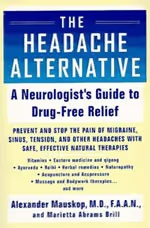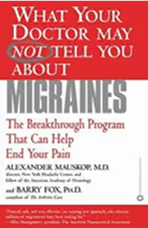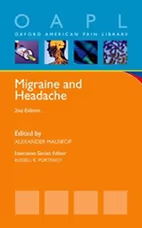Medications
In addition to the information you see on this page, please check my series of blog posts, 100 Migraine Drugs, A to Z.
While we are big advocates of non-drug treatments, many people do require the use of medications to control headaches. Headache medications are divided into two categories. Abortive drugs are those that are used as needed when the headache occurs. They can be sufficient when headaches are infrequent. Prophylactic drugs are used for people with frequent attacks, and they are taken daily to prevent headaches. Many patients express the concern that they will need to take a daily medication for the rest of their lives. This is not usually the case. Daily prophylactic drugs are used until the headaches are under control, at which point they are tapered off. Research indicates that once headaches become well controlled with medications or Botox injections these treatments can be successfully discontinued in 50% of patient. We also try to use the lowest effective dose possible for the shortest period possible.
Drug Treatment for Tension-type headaches
Abortive medications such as painkillers and anti-inflammatory drugs are effective in treating tension-type headaches. Medications containing caffeine or opioids (narcotics) should be limited to 1 to 2 doses per week because using them more often can lead to an increase in frequency of attacks, or so called rebound headaches. Patients who need more than this amount generally need daily prophylactic medication.
a. Non-steroidal anti-inflammatory drugs (NSAIDs) such as aspirin (Migralex, a drug developed by Dr. Mauskop), ibuprofen (Motrin, Advil), naproxen (Naprosyn, Anaprox), aspirin or aspirin/acetaminophen/caffeine combination (Excedrin) can be helpful in stopping a headache attack.
b. Codeine, hydrocodone (Vicodin), oxycodone (Percocet) are rarely needed for tension-type headaches and should be avoided.
c. Prescription drug combinations can be effective for some patients. The combination of acetaminophen or aspirin with caffeine and a short acting barbiturate butalbital is very popular with many patients (Fiorinal, Fioricet, Esgic, Medigesic), but pose the risk of worsening headaches and causing addiction.
Prophylactic therapy
Antidepressant drugs are the first-line treatment for severe and frequent headaches. The most effective antidepressants are the tricyclic antidepressants (TCA) such as nortriptyline (Pamelor) or amitriptyline (Elavil). Another group of antidepressants, the selective serotonin reuptake inhibitors (SSRIs), can be effective with fewer side effects. SSRIs include fluoxetine (Prozac), escitalopram (Lexapro), citalopram (Celexa), sertraline (Zoloft) and paroxetine (Paxil). Patients often prefer SSRIs because these drugs, unlike TCAs, are less likely to cause weight gain, constipation or excessive drowsiness. However, they can cause sexual dysfunction, such as loss of libido or inability to reach an orgasm. Duloxetine (Cymbalta), venlafaxine (Effexor), and milnacipran (Savella) belong to the SNRI group of antidepressants and are proven to relieve various pain conditions, including headaches, regardless whether the patient is depressed or not.
Despite the fact that stress and tension can be a cause of tension headaches, the use of tranquilizers should be avoided. Long-term use of these drugs can lead to addiction and worsening of headaches. Botulinum toxin (Botox) injections into the muscles around the head are being tested as a prophylactic therapy for chronic tension headaches.
Pharmacological treatment for Migraine Headaches
Abortive therapy
a. Non-steroidal anti-inflammatory agents mentioned above can be effective for migraine headaches. Fast action can be achieved by using Migralex. Sometimes prescription NSAIDs are also used.
b. Combination medications, such as Fioricet, listed in the section on tension headaches are rarely effective for migraines. Addition of codeine to some of the combinations (Fiorinal with codeine and Fioricet with codeine) improves their efficacy, but the side effects can increase as well.
c. Dihydroergotamine (DHE-45) is effective for abortive treatment of migraines. This drug is available as an injection and a nasal spray. A nasal spray form of dihydroergotamine (Migranal) is more convenient to take, but it is less effective. By the end of 2012 we expect FDA approval for an inhaled formulation of dihydroergotamine (Levadex), which appears to be very effective and less likely to cause nausea then the injection.
d. If nausea is present with the headache, anti-nausea medications can be given. These come in the form of injections, tablets, and suppositories. Some examples are prochlorperazine (Compazine), metoclopramide (Reglan), and ondansetron (Zofran).
e. Triptans are a true breakthrough in the treatment of migraines. They were specifically developed to go to the source of the migraine and turn it off. They relieve not only the pain, but also all the associated symptoms of a migraine (such as nausea, light and sound sensitivity). These drugs are not identical, so if one does not work or causes side effects, another one in this group should be tried. There are seven available triptans, and many patients respond to only one of them. The triptans are sumatriptan (Imitrex), zolmitriptan (Zomig), rizatriptan (Maxalt), naratriptan (Amerge), frovatriptan (Frova), eletriptan (Relpax), and almotriptan (Axert). They differ in their time to effectiveness, length of effect, and side effect profiles. All of these drugs are available as tablets, and Imitrex is also available in injection. Zomig and Imitrex are available in a nasal spray, while Maxalt and Zomig come in a “melt in your mouth” form. The non-tablet forms are especially helpful for patients with severe nausea.
Prophylactic therapy
a. Tricyclic and SNRI antidepressants can be as effective for migraine headaches as they are for tension-type ones and other painful conditions.
b. Blood pressure medications, such as propranolol (Inderal), atenolol (Tenormin), nebivolol (Bystolic) and other beta-blockers (a type of blood pressure medications) are good prophylactic drugs. The effective dose for propranolol can be as low as 40 mg daily but is usually 80 to 240 mg. Nebivolol (Bystolic) has the least side effects, but is more expensive because it is not available in a generic form. Patients with asthma, slow heart rates, heart block, congestive heart failure, and diabetes cannot use these drugs. Calcium channel blockers (another type of blood pressure medication), such as verapamil (Calan) are sometimes effective for migraines, but are more likely to benefit a patient with cluster headaches. ACE receptor blockers, such as candesartan (Atacand), losartan (Cozaar) and olmesartan (Benicar) are newer blood pressure medications and have been proven to be effective in preventing migraine attacks.
c. Antiepilepsy drugs, such as topiramate (Topamax) or divalproex sodium (Depakote) also relieve migraine headaches. Potential side effects include nausea, drowsiness and weight gain with Depakote or weight loss with Topamax. Topamax can also cause difficulty with memory and thinking and both are contraindicated in pregnancy. Gabapentin (Neurontin) has fewer side effects and can be fairly effective.
e. long-acting NSAIDs, such as meloxicam (Mobic) can work well for prevention of migraines.
f. Botulinum toxin (Botox) injections into the muscles around the head and neck is one of the most effective treatments for the prevention of migraines with hardly any side effects. The effect lasts for 2-4 months. (See chapter on Botox)
Pharmacological treatment for Cluster Headaches
Abortive therapy
The treatment of cluster headaches begins with reducing the pain of each attack while waiting for prophylactic drugs to take effect. If cluster periods occur infrequently, the prophylactic drugs can be weaned off after the cluster period ends.
a. The most benign and frequently effective treatment is oxygen therapy. The oxygen is given through a mask at a high flow rate of 10 liters per minute for 10 to 15 minutes. It should be used for patients who get most of their attacks at home. If headaches occur during the day, patients can possibly store another oxygen tank at work.
b. Sumatriptan (Imitrex) injection is very effective in most patients and has few side effects. It can be self-administered by the patient using an auto-injector.
3. Dihydroergotamine (DHE-45) is given by injection and can also be self-administered by the patient.
Prophylactic therapy
a. A short course of corticosteroids (prednisone) will frequently stop the entire cluster episode. It is started at 80 – 100 mg daily and then is tapered down over a period of two weeks.
b. Infusion of one gram of magnesium sulfate can also abort the cluster period in up to 40% of patients.
c. Occipital nerve block with a local anesthetic lidocaine and a long-acting corticosteroid Depo-Medrol can also abort a cluster period in some patients.
d. Calcium channel blockers such as verapamil (Calan, Isoptin) are started in patients who don’t respond to a course of prednisone.
e. Antiepilepsy drugs, such as divalproex sodium (Depakote) 750-2000 mg daily and topiramate (Topamax) can be very effective.
f. Lithium is a mood stabilizer which can work for both episodic and chronic forms of cluster headaches.
g. Over-the-counter melatonin, 10 mg nightly has been reported to help a few patients with clusters. Intranasal capsaicin has been also used to prevent clusters. It is applied into the nostril on the side of the headache twice a day.
.jpg)



This “book” appears to have largely been born out of his blog from the New York Headache Center. For years, he has regularly put up information, scientific and clinical, for his headache followers. He has created this “book,” actually an e-book, which takes relevant information from his experience and knowledge of migraine. There is no need for an index and chapter references. He uses hyperlinks, embedded in the e-book, to connect to material online, which he puts in context for the reader. This works very well as one hyperlink may go to an original paper or publication or a resource site.
He links to major medical journals including headache journals and his own publications, when helpful, as well as nonmedical literature and other sites. This format allows the e-book to be updated from time to time, which is easy to do with this approach.
The book has a very interesting introduction and deals with evidence-based medicine and its role in migraine therapy. When he begins the section on 150+ treatments, he starts with a very interesting comment. Many of the treatment ideas that I describe in this book are not just off-label (that is, not approved by the FDA) but may appear to be off-the-wall. It is refreshing to hear such intellectual honesty from a practicing neurologist.
There is a great section on supplements and finding someone to help with your migraine, such as coach, a partner, or a sympathetic friend. A diagnostic discussion follows and is most helpful, as proper diagnosis directs treatment, as are the detailed sections on triggers including environment, food, exercise, physical therapies, and sleep. Herbal therapies are covered as is neuromodulation and injections/blocks among others.
In the sections on drugs, he deals with acute therapies and the modern use of triptans and gepants, and a ditan. Preventive therapies start with monoclonal calcitonin gene-related peptide antibodies, tricyclic medications, and many other preventive therapies including beta blockers, anti-seizure drugs, nonsteroidal anti-inflammatory drugs, and botulinum injections. From acupuncture to Feldenkrais methods, he covers the contemporary plethora of migraine “treatments” as he sees it in practice.
He ranks all medications on a 1 to 10 scale regarding his own subjective opinions of the utility of each treatment. He indicates that no treatment gets 10 as a score and any receiving a score of 1 were not rated. He also lists his favorite migraine therapies separately. He includes a lot of data links here, from single case reports to full-scale randomized clinical trials, and detailed reviews. His clinical acumen shines through the volume and one gets the impression that this is a very personal view at times, not always backed by evidence, as there may not be any, but by experience, practice and pragmatism. He carefully notes the general things to be careful of in taking some treatments and warns if there are serious concerns. Nonetheless, he indicates clearly that the advice of a medical professional should be sought before trying the therapies mentioned.
Diagnosing secondary headache that can mimic migraine or vice versa is a useful section but does not go into depth about the disorders/diseases mentioned, as this is not the intention of the book. Special circumstances are given sections including menstrual migraine, pregnancy, resistant/refractory headache, aura and headache, and many others.
The author is a senior, highly experienced neurologist and has a high degree of interest in migraine and other headache disorders. He has a sense of curiosity about the brain and migraine and that comes through to the reader of this small volume. I count 23 endorsements, including the excellent foreward of the book from a wide range of well-known people, which includes two prior editors of this journal. He is well liked and highly respected by his colleagues.
In many ways, this book does what online databases on diseases cannot do most times. He tells the reader what he knows and how to use that knowledge. He directs the novice and experts to the right literature and takes the reader on a personal journey through the field of migraine treatments. He tells people, “…keep seeking relief, not to give up on or blame yourself for the pain you experience from migraine.”
There is a printed version of the book; however, the e-book is ideal for the intended purpose. I would recommend it the first instance. It is available via a commercial site and inexpensive.
I would recommend this book to anyone who has migraine or cares for people with migraine and wants a broad and sometimes detailed overview of the treatments. Available in the e-book format, it represents a lot of work for one person, but his passion, occasional humor, and historical perspectives are evident in this work. You don’t have to agree or accept everything the author says to enjoy and benefit from this “book,” and I know he would want people to be critical and skeptical where warranted. However, you will find more than you would usually need to know from this banquet of 150 ways to help your migraines! Enjoy, I did very much. Read it through once and save as reference.
Alexander Mauskop, Director of the New York Headache Center, and Marietta Abrams Brill, a freelance medical writer, have written principally for headache sufferers in North America. They answer questions like “is Rolfing covered by medical insurance?”, and include an excellent resource section in the back. of the book which lists American organizations for the various therapies. But they provide enough background information on both headache and alternative treatments to make their book interesting to readers from other countries, too. In covering most of the more common alternative therapies~like herbs, acupuncture, massage, Ayuverda and Eastern medicine, and qigong-they aim to inform rather than judge, cite research evidence where it exists, and point to potential dangers as well as benefits.
Each of the 10 chapters is introduced with a pithy quote: “Divine is the work to subdue pain” (Hippocrates) heads the first chapter. After general background on pain theories and headache diagnosis, common alternative approaches are covered in turn and there is, of course, oodles of advice on diet and nutrition. A helpful glossary guides readers through words that conventional doctors are familiar with, like Scotoma, and those with which we aren’t, like Qi, Vatta, and Pitta. To round off, a comprehensive resource section and selected bibliography give useful directions to readers wanting more information about specific therapies.
Like all good guides, this one follows a logical structure and so it is relatively simple to go quickly to the information you want to find. It is easy to read. All in all, it is a guide which headache sufferers looking for good information on alternative therapies can be thankful for.
